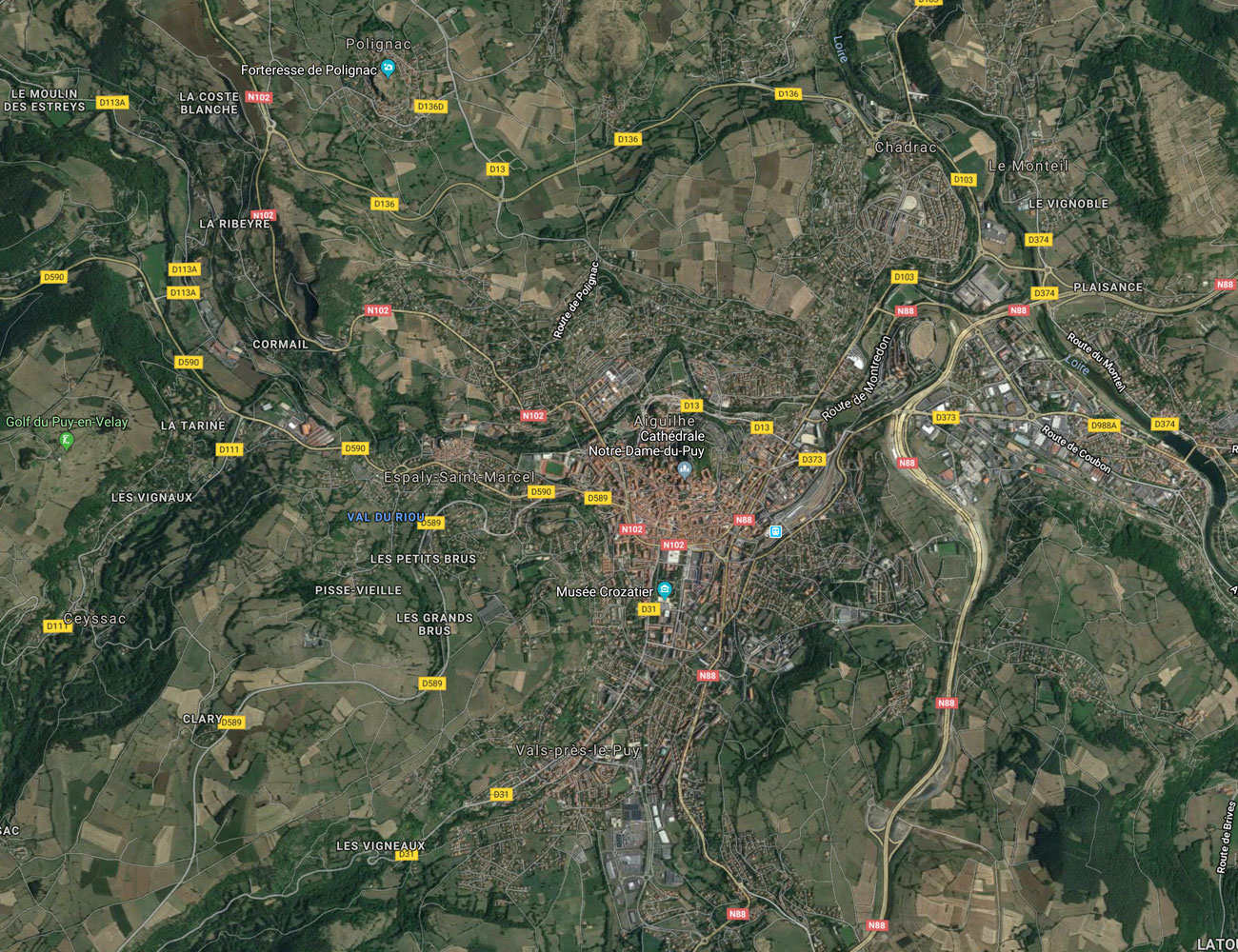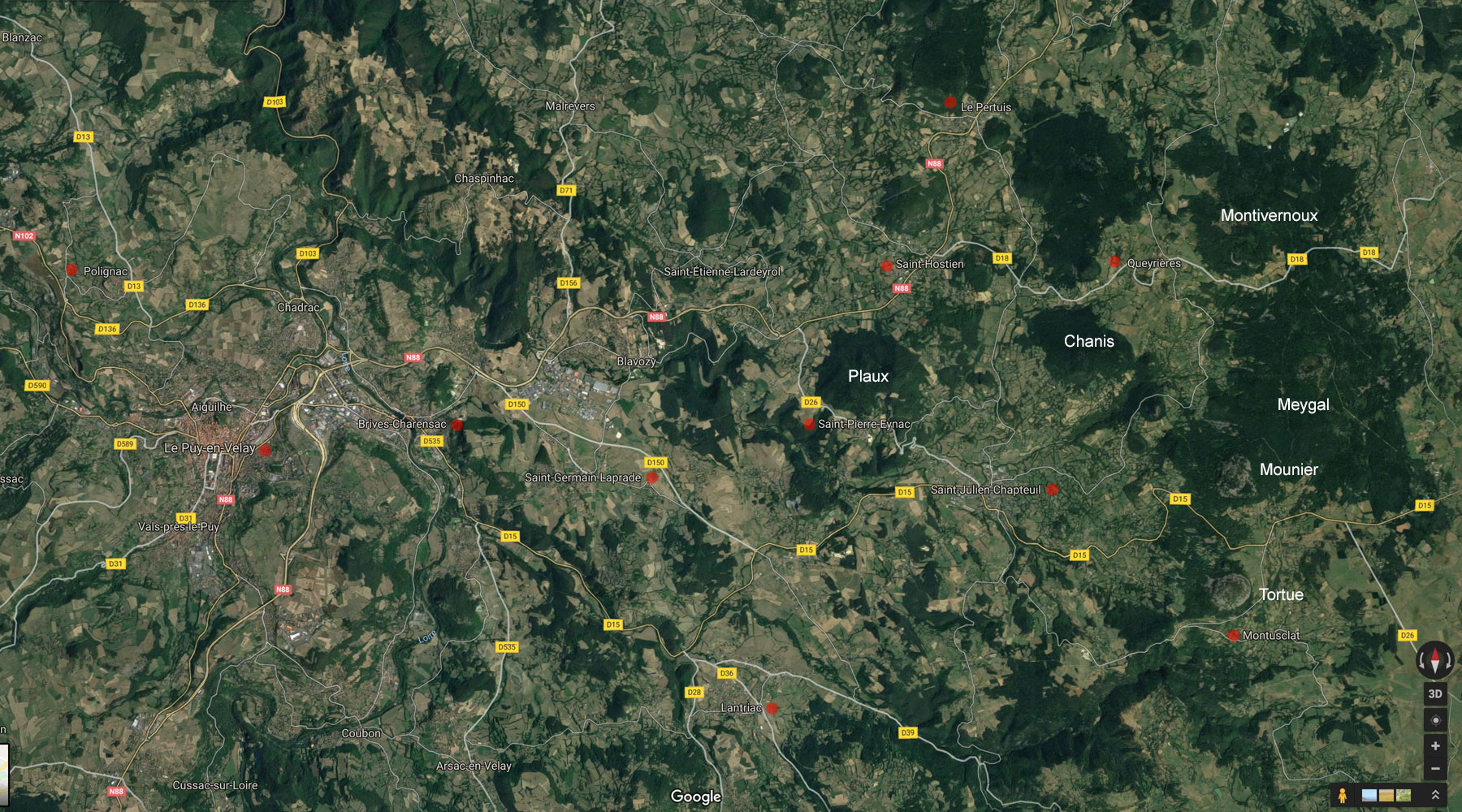Towns and Villages: Le Puy
About Le Puyv-en-Velay | Additional Information | Maps | Photo Album | Links
This page introduces the town of Le Puy, the capital of the departements Haute Loire.
About Le Puy-en-Velay
Le Puy-en-Velay, or Le Puy for short (on 18 March 1988 the name of the city was changed from Le Puy to Le Puy-en-Velay), is the capital of the department of Haute Loire and is quite in the middle of it. It has almost 20,000 inhabitants (19,300) and is situated at an average altitude of 630 metres. It is striped by the Loire and is certainly the most important place in the department, as it is the seat of the departmental administration and other central facilities.
The main attractions are the Cathedral of Notre-Dame, the red Madonna statue of Notre-Dame-de-France and the rock of Saint-Michel d'Aiguilhe with the chapel of the same name. They are discussed below.
Le Puy is an important stop on the Way of St James to Santiago de Compostela. Two branches of the Way of St James lead to Le Puy: the Way of St James coming from Burgundy (Burgundy Way of St James, collects pilgrims from southern Germany and Alsace) and the Via Gebennensis coming from Geneva meet there. The Via Gebennensis passes through Saint-Julien-Chapteuil, where many pilgrims pass by and spend the night, so that there are numerous Swiss and German pilgrims. From Le Puy, the Via Podiensis (Latin via = path, podium (= Le Puy) = hilltop) leaves, one of the four historic St James Routes in France. The Via Podiensis leads from Le Puy-en-Velay to Saint-Jean-Pied-de-Port in the Pyrenees (and from there, of course, to Santiago de Compostela). More about the Way of St James on the website Way of St James in Europe!
Since 1986, every third weekend in September, the Fêtes Renaissance du Roi de l'Oiseau has taken place in Le Puy, reviving the Renaissance. However, we have never been able to go there, although the festival was highly recommended to us (see traffic chaos...).
Le Puy is also a city of lace-making, which means that the whole Velay was a centre of this craft. More information (French, English) on the website of the Centre d'Enseignement de la Dentelle au Fuseau (C.E.D.F)! In addition to this facility, there are many shops selling lace products in the old town of Le Puy. A museum of lace making (Musée des Manufactures de Dentelles) is located in Retournac; we have already visited it.
Le Puy is also known for its small green lentils, which are grown on a large scale in the Velay. We have already exported them. "In terms of taste, they are considered an aromatic delicacy. They taste particularly nutty and keep a crunchy bite after cooking," says the Website PuyLinsen.de, which offers more information about these lentils!
Le Puy, by the way, has a constant traffic chaos and there are no parking spaces. Unfortunately there are no buses from Saint-Julien-Chapteuil to Le Puy, so we haven't been to Le Puy for a long time - except in the big hospital when Mr. Girard was there.
Now to the most important sights in and around Le Puy!
Cathedral
The most important building in Le Puy is certainly the Cathedral of Notre-Dame, which stands at the foot of the volcanic cone of Rocher Corneille and is made of colourful volcanic rock that gives it its characteristic appearance (a similar church can still be found in Le Monastier-sur-Gazeille). The oldest parts of the choir date back to the second half of the 11th century. The building stands out not only for its sublime location, but also for its magnificent façade. Work on the nave began in the 12th century.
Among other things, the cathedral has a black statue of the Madonna (statue of Notre-Dame du Puy, Black Virgin), which is the destination of many pilgrims. It also has a cloister and a museum with ecclesiastical treasures. Built in the 11th and 12th centuries, the cloister is considered one of the most beautiful Romanesque ensembles in Europe. The semicircular arches are crowned by a mosaic of white, red and black diamonds. The chapter house is decorated with a fresco of the Crucifixion. In the cloister there is also a remarkable series of historic 12th century capitals: the four evangelists, a centaur race, an abbot and an abbess fighting for lacrosse. The cathedral treasury contains an exceptional collection of liturgical ornaments and embroidered devotional images from the 15th to 20th centuries, collected over more than thirty years.
Aiguilhe
The 82 m high rock of Saint-Michel d'Aiguilhe (Saint Michael on the needle) is another landmark of the city and is a released volcanic chimney that was formed about 2 million years ago. According to various sources, it is considered one of the most remarkable volcanic sites in France and, together with the chapel of Saint-Michel d'Aiguilhe on its top, built by Bishop Gothescalk in 961, it is an exceptional ensemble. The staircase up to the chapel has 268 steps, by the way! More details can be found on the Tourist Destinations in Le Puy-en-Velay website.
The Statues of Notre-Dame-de-France and Joseph
The monumental statue of the Madonna by Notre-Dame-de-France was cast from the cast metal of 213 cannons between 1856 and 1860 according to plans by sculptor J. M. Bonnassieux. The cannons were captured near Sevastopol during the Crimean War and donated by Napoleon III. It measures 22.70 m and weighs 835 tons, is painted pink today and is illuminated at night. It is hollow inside and accessible, but was closed to the public for a long time.
The Madonna holds the Child Jesus in her right arm. We have heard the following rumour: when the sculptor learned that this was the wrong arm, he threw himself from the Madonna to his death. But this is obviously a "fairy tale". Bonnassieux died in 1892 in Paris at the age of almost 82...
You can see the statue of the Madonna from afar, like the fortress of Polinac, and it is one of our "favourite pastimes" to look for both with the naked eye and binoculars.
For a long time we didn't know that there was also a large statue of Joseph in Le Puy. It belongs to the Sanctuary of Saint Joseph de Bon Espoir (St. Joseph of good hope) and is located in the heart of the Borne Valley on the Basilica of Saint Joseph de Bon-Espoir d'Espaly, on the site of the former chapel of a fortified castle. The monumental statue is 22.40 metres high and seems to respond to Notre-Dame de France on the Corneille rock at Puy-en-Velay. It was completed in 1918 and is the work of Brother André Besqueut. It is good to see if you drive up the N102 to the northwest to get a nice view of Le Puy. By the way, the N102 continues to a turnoff to Polignac, a fortress with a huge tower (see below).
Polignac
The fortress of Polignac (forteresse de Polignac) overlooks the municipality of Polignac, northwest of Le Puy-en-Velay. Situated on a volcanic rock slab, which drops steeply on all sides, the fortress has a strategically unique location. The volcanic rock is easy to work and was an ideal material for the first builders. The fortress has belonged to the same family for 1000 years, whose history has shaped not only the Velay but also France. From the terrace you have a wonderful view of the Velay mountains, the town of Le Puy-en-Velay, the Mézenc and Meygal massifs, the valleys of Borne and Loire, the extinct volcano Mont Bar next to the town of Allègre. (To burgen.de, modified)
Conversely, the fortress of Polinac, like the statue of the Madonna, can also be seen from afar, and it is one of our "favourite pastimes" to look for both with the naked eye and binoculars.
Additional Information
Numbers
- Inhabitants: 19,300
- Postal code: 43000
- Average altitude: 630 m
Curiosities
- Cathedral of Notre-Dame, cloister, museum, old town
- Madonna statue of Notre-Dame-de-France, Saint Joseph de Bon Espoir (St. Joseph of good hope) with Joseph statue
- rock and chapel of Saint-Michel d'Aiguilhe
Well-Known Persons
- ???
Facilities
- Centre d'Enseignement de la Dentelle au Fuseau and shops selling bobbin lace work
Specialties
- Renaissance festival of the king of birds (Fêtes Renaissance du Roi de l'Oiseau)
- bobbin lace work
- green lentils of Le Puy
Towns and Villages Near-by
- Polignac
- Brive-Charensac
- Blavozy
Road Connections
- N88 (comes from Saint-Etienne in the east, goes on to Langogne and Mende in the south)
- 102 (comes from the southeast of Montelimar, runs together with the N88 from Pradelles to le Puy, continues from Le Puy further northwest to Brioude)
Curiosities in the Environment
- Meygal massif
- Gorge de la Loire
Maps
Map of Le Puy-en-Velay including Polignac
Map beginning with Le Puy-en-Velay (and Polignac) in the west to the Meygal massif in the east
Photo Album
In preparation
Links
- Le Puy-en-Velay: de.wikipedia.org/wiki/Le_Puy-en-Velay
- Tourism Website for Le Puy-en-Velay: www.lepuyenvelay-tourisme.fr
- Tourist attractions in Le Puy-en-Velay: www.lepuyenvelay-tourisme.fr/mon-sejour/visiter/visiter-le-puy-en-velay/
- Fêtes Renaissance du Roi de l'Oiseau: www.roideloiseau.com
- Centre d'Enseignement de la Dentelle au Fuseau (C.E.D.F): www.ladentelledupuy.com
- Statue de Notre-Dame de France: fr.wikipedia.org/wiki/Statue_de_Notre-Dame_de_France
- Saint Joseph de Bon Espoir: www.josephbonespoir.org
- Forteresse de Polinac (burgen.de): www.burgen.de/burgen-und-schloesser/frankreich/forteresse-de-polignac/
- Ways of St James in Europe: www.jakobswege-europa.de
- Lentilles de Le Puy (PuyLinsen.de, in German): www.puylinsen.de
| 18.03.2019 |

